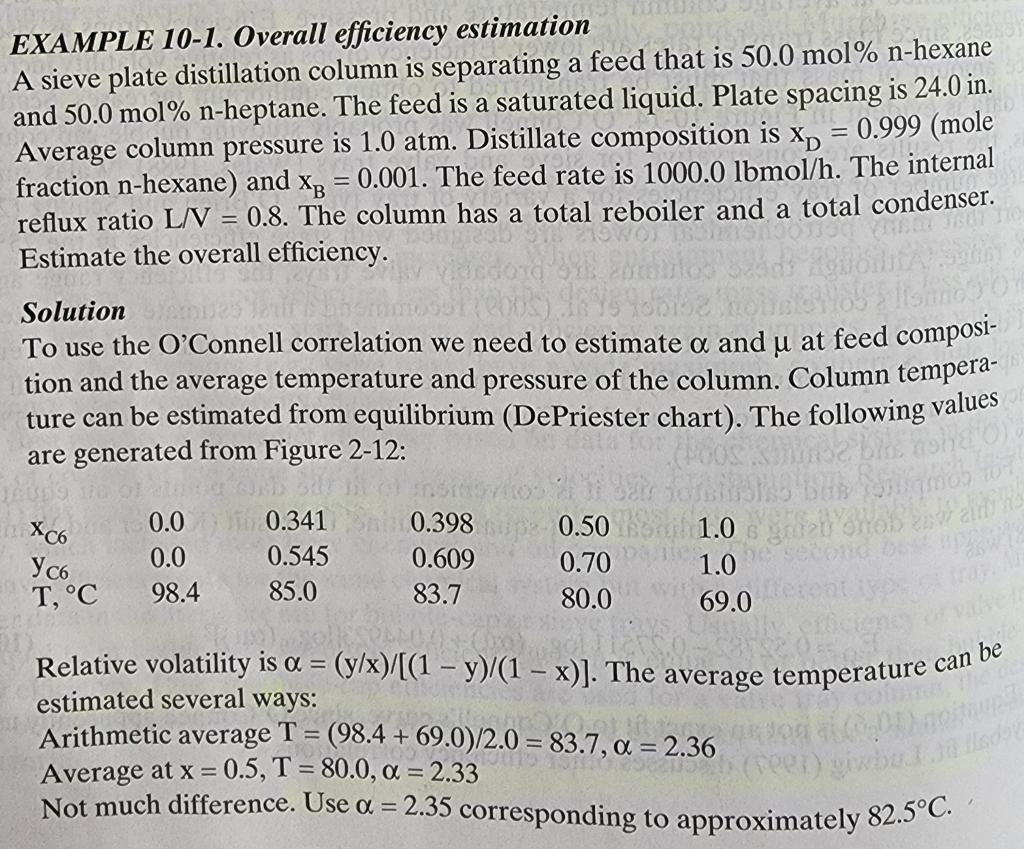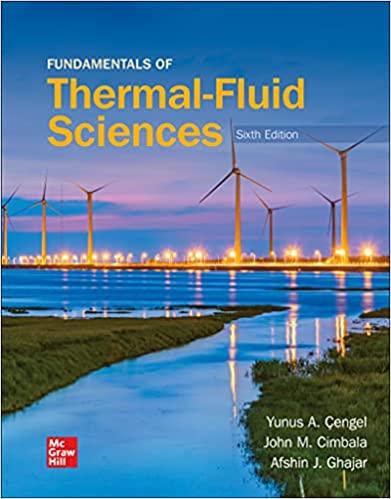Answered step by step
Verified Expert Solution
Question
1 Approved Answer
This is Example 10-1: This is example 10-2: Now Solve The following Question according to these ones: Please Solve Correctly with Clear Hand Writing, Thanks.
This is Example 10-1:

 This is example 10-2:
This is example 10-2:

Now Solve The following Question according to these ones:

 Please Solve Correctly with Clear Hand Writing,
Please Solve Correctly with Clear Hand Writing,
Thanks.
Inico EXAMPLE 10-1. Overall efficiency estimation A sieve plate distillation column is separating a feed that is 50.0 mol% n-hexane and 50.0 mol% n-heptane. The feed is a saturated liquid. Plate spacing is 24.0 in. Average column pressure is 1.0 atm. Distillate composition is xp = 0.999 (mole fraction n-hexane) and Xp = 0.001. The feed rate is 1000.0 lbmol/h. The internal reflux ratio LN = 0.8. The column has a total reboiler and a total condenser. Estimate the overall efficiency. Solution Sobib To use the O'Connell correlation we need to estimate a and at feed composi- tion and the average temperature and pressure of the column. Column tempera- ture can be estimated from equilibrium (DePriester chart). The following values are generated from Figure 2-12: Si bus gimo 0.0 0.341 0.398 0.50 1.0 tons 6 0.0 0.545 0.70 1.0 T, C 98.4 85.0 83.7 80.0 69.0 Relative volatility is a = (y/x)/[(1 - y)/(1 x)]. The average temperature can be estimated several ways: Arithmetic average T = Average at x = 0.5, T = 80.0, a = 2.33 (reen www Not much difference. Use a = 2.35 corresponding to approximately 82.5C. c6 0.609 FUMO = (98.4 + 69.0)/2.0 = 83.7, a = 2.36 The liquid viscosity of the feed can be estimated (Reid et al., 1977, p. 462) from In U mix = x, In My + x2 In uz (10-7a) The pure component viscosities can be estimated from 1 log10u = A[ = ALI (10-7b) T B where u is in cP and T is in Kelvin (Reid et al., 1977, App. A). nC : A = 362.79, B = 207.08 nCy: A = 436.73, B = 232.53 = These equations give uco = 0.186, Mcz = 0.224, and Mmix = 0.204. Then au mix 0.480. From Eq. (10-6), E. = 0.62, while from Figure 10-14, E. = 0.59. To be conservative, the lower value would probably be used. o Note that once T and Ufeed have been estimated, calculating E. is straightforward. token with an Oldershaw column (a davg? avg' EXAMPLE 10-2. Diameter calculation for tray column Determine the required diameter at the column top for the distillation column in Example 10-1. Solution We can use Eq. (10-16) with 75% of flooding. Since distillate is almost pure n-hexane, we can approximate properties as pure n-hexane at 69.0C. Physical properties: P2 = 0.659 g/ml (at 20); viscosity = 0.22 cP; MW = 86.17 (Perry and Green, 1984). Surface tension o = 13.2 dynes/cm (Reid et al., 1977, p.610). The ideal gas law is used to estimate vapor density. 1b (latm)(86.17 Ibmo1 = 0.19171b/ft3 (342K) K lbmol Pc = (0.659)(62.4) = 41.12 lb/ft? (will vary but not a lot). At the top of the column P(MW) P = RT (1.314 atmft MW. = MW and W L MWL -=0.8 w V MW V The flow parameter is F W (Px)05 = 0.0546 W, Pu Ordinate from Figure 10-16 for 24-in, tray spacing, C = 0.36 while C = 0.38 from Eq. (10-10e). Then 13.2 302 = 0.331 20 =K K=C0 () 02 = 0.361 20 K = 0.35 if Eq. (10-10e) is used. The lower value is used for a conservative design. From Eq. (10-8) PL-P 41.12-0.1917 U flood =(0.331) -0.5 = 4.836 P 0.1917 We will estimate n as 0.90. V = L + . From external mass balances, D = 500.0. Since L = V(L/V) and L/V +0.8, DV 500 V 2500 lbmol/h 1-L/V 0.2 Diameter Eq. (10-16) becomes 4(2500)(1.314)(342) Dia = = 11.03 ft T: (0.90)(3600)(1)(075)(4.836) Since Fair's diameter calculation procedure is conservative, an 11.0-ft diam- eter column would probably be used. If n = 0.95, Dia = 10.74 ft; thus, the value of n is not critical. This is a large-diameter column for this feed rate. The reflux rate is quite high, and thus, V is high, which leads to a larger diameter. The effect of location on the diameter calculation can be explored DS. Repeat Example 10-2 exept calculate the diameter at the bottom of the column at a pressure of 700.0 kPa. The surface tension of pure n-heptane at 20C is 20.14 Homework 427 dynes/cm (0.0214 N/m), and the temperature coefficient is -0.0980 dynes/cm/K (www .surface-tension.de). Use the DePriester chart to estimate bottoms temperature. We are testing a new packing for separation of benzene and toluene. The column oboilorStep by Step Solution
There are 3 Steps involved in it
Step: 1

Get Instant Access to Expert-Tailored Solutions
See step-by-step solutions with expert insights and AI powered tools for academic success
Step: 2

Step: 3

Ace Your Homework with AI
Get the answers you need in no time with our AI-driven, step-by-step assistance
Get Started


